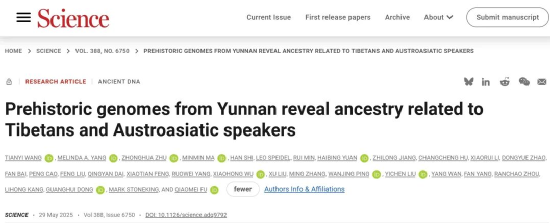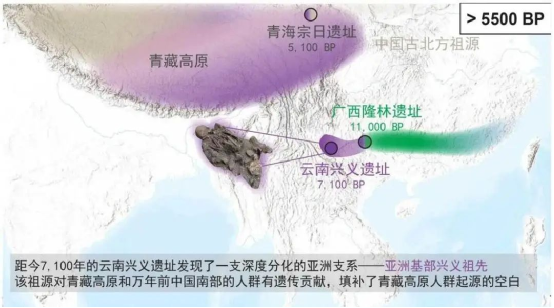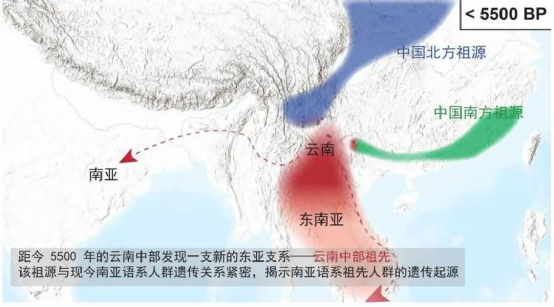Science | Center for Archaeological Sciences, Sichuan University and Collaborating Institutions Publish Paleogenomic Research: Revealing the "Ghost Ancestor" of the Tibetan Plateau and the Genetic Origins of Austroasiatic-speaking Populations

Recently, our Center, in collaboration with the team led by Fu Qiaomei from the Institute of Vertebrate Paleontology and Paleoanthropology, Chinese Academy of Sciences (IVPP, CAS), and other institutions, systematically studied 127 ancient human genomes from 17 sites in Yunnan Province, dating back over the past 7,100 years. This research fills a gap in the prehistoric human genetic data for the region, precisely identifies the "ghost ancestor" component of the Tibetan Plateau from a genetic perspective for the first time, and reveals the genetic origins of Austroasiatic-speaking populations and the crucial role of Yunnan as a hub for diverse population interactions. The findings were published in the international academic journal *Science* on May 30, 2025, under the title "Prehistoric genomes from Yunnan reveal ancestry related to Tibetans and Austroasiatic speakers," and were highlighted as a research feature.
The first breakthrough of this study is the initial discovery of the Tibetan Plateau "ghost ancestor."
The genetic structure of Tibetan Plateau populations has long been a focus of academic attention. According to previous research, from 5,100 years ago to the present, about 80% of the genetic components of Tibetan Plateau populations originate from northern Chinese populations dating between 9,500 and 4,000 years ago. The remaining 20% has an unknown origin, termed the "ghost ancestor" by academia. The source of this component had remained undetermined and has garnered significant academic attention. Through gene capture and sequencing, this study identified a new, deeply diverged Asian genetic component in the genome of an individual (Xingyi_EN) from the Xingyi site in Yunnan, dating back 7,100 years. The research team designated it as "Basal Asian Xingyi Ancestry." The study shows that this genetic component not only contributed to ancient Tibetan Plateau populations but is also widely present in the genomes of modern Tibetan populations. The ancient population represented by Xingyi_EN is one of the components of the Tibetan Plateau "ghost ancestor" that has been of interest to academia but had not been precisely located before, providing new evidence for the migration and evolutionary processes of East Asian populations.

The second important finding of this study is the confirmation that Yunnan may be one of the core areas for the early distribution of Austroasiatic-speaking populations.
The origin and dispersal of Austroasiatic-speaking populations, such as the Wa and Blang ethnic groups, primarily distributed in Southwest and South China, Northeast India, and Southeast Asia (including some ethnic groups in Vietnam, Cambodia, Laos, etc.), have long been debated, especially regarding their place of origin, dispersal time, and routes. Current mainstream hypotheses are derived from linguistic models and lack direct genetic evidence. Through ancient genome capture, sequencing, and analysis, this study identified a new, distinct East Asian ancestry in ancient populations from central Yunnan dating between 5,500 and 1,400 years ago. The research team named it "Central Yunnan Ancestry." Analysis indicates this ancestry is closely related to present-day Austroasiatic-speaking populations, refuting previous theories of an Indian or Southeast Asian origin for these groups and proposing a re-examination of issues such as the formation and dispersal patterns of Austroasiatic-speaking populations.

This research was completed through a 9-year collaboration involving the team led by Fu Qiaomei from the Institute of Vertebrate Paleontology and Paleoanthropology, Chinese Academy of Sciences (IVPP, CAS), Sichuan University, the Yunnan Provincial Institute of Cultural Relics and Archaeology, Lanzhou University, and other institutions. The co-first authors of this paper include Wang Tianyi, a doctoral student at the Institute of Vertebrate Paleontology and Paleoanthropology, Chinese Academy of Sciences (a 2014 undergraduate alumna of our university's School of History and Culture); Assistant Professor Melinda A. Yang from the University of Richmond, USA; Zhu Zhonghua, a doctoral student at the School of Archaeology and Museology, Sichuan University; and Professor Ma Minmin from Lanzhou University. The corresponding author is Researcher Fu Qiaomei from the Institute of Vertebrate Paleontology and Paleoanthropology, Chinese Academy of Sciences. Associate Professor Yuan Haibing from the Center for Archaeological Sciences, Sichuan University, and others also participated in the collaborative research.
